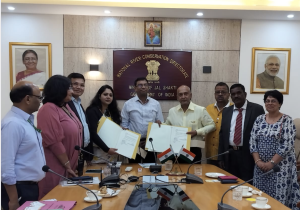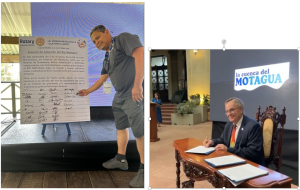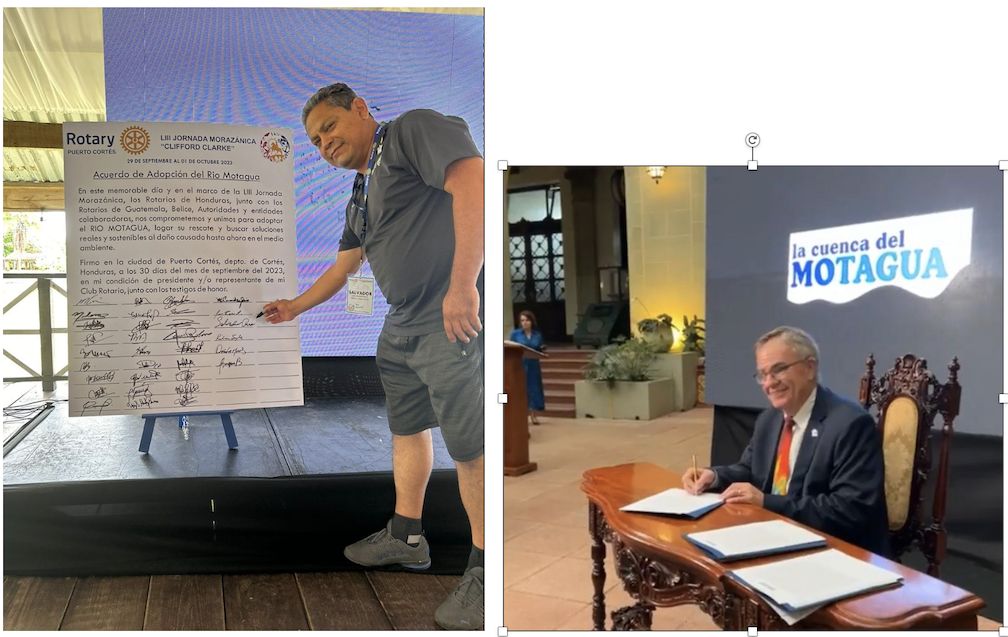By Dr. Mina Venkataraman, ESRAG Director
Rotary and UAE Rotaractors will anchor two pavilions at COP 28 in Dubai, one in the Blue Zone and one in the Green Zone. Top Rotary leaders including RI President Gordon McInally, Rotary Foundation Chair Barry Rassin, and Rotary General Secretary and Chief Executive Officer John Hewko will lead the Rotary delegation. Their attendance marks a major advance in how Rotary will connect at COP 28 as a potential partner in climate solutions. But whether we live into that potential or not will depend on really stepping up our action in proving our effectiveness.
Rotarians are people of action and we have brought about tremendous changes. What we lack is effective project impact reporting. Without data, we are losing out on a lot of funding that could come our way to implement solutions. This article will outline some of the reasons Rotarians are well-positioned to accelerate climate action. But unless we provide a track record to show our impact, we won’t be credible to funders or partners.
Presenting Rotary’s potential at COP:

Rotary action bearing fruit: Rotarians and representatives of the National River Conservation Directorate of India’s Ministry of Water signing a Memorandum of Understanding for the conservation of the River Cooum in India. ESRAG Director Dr. Mina Venkataraman (in rose) and RID 3232 DG Ravi (in yellow shirt) signed on behalf of Rotary. The project team, which included RID 3232 Rotarians Dr. Irulandi and Radhakrishnan, worked more than 40 months to bring this agreement together.
The Blue Zone is restricted to accredited party and observer delegates who will be conducting formal negotiations, as well as the World Climate Action Summit, country pavilions and hundreds of panels, round tables, and other side events. Rotary’s goal in the Blue Zone will be to showcase how Rotary’s work covers all of the other Sustainable Development Goals, that we are present in all parts of the world, and we are here to be an implementing partner. We already do work with partners who will be presenting in our panels in the pavilions. Rotarians are positioned to collaborate at every level, from local communities to international partnerships.
The Green Zone is open to delegates, the public and private sector, NGOs, innovators and start-ups, and the public. Rotary’s Green Zone pavilion, which is being organized by Rotary UAE (United Arab Emirates) Rotaractors, will be part of this vast networking space. As Rotary International’s representative in the Green Zone along with our team of 20 other Rotarians, we will be looking for opportunities for ESRAG and Rotary clubs around the world to make connections to people and institutions leading creative and promising initiatives. For example, Microsoft arena will have three Earthshot winners whose work collectively spans East Africa, India and South America
We are making the case that Rotary is not working in silos. The credibility Rotarians have earned through our humanitarian work will help us convince others of the synergies between the SDGs and climate mitigation: that it’s all interconnected. We will be covering all of the SDGs during Rotary’s presentations on the theme days during COP 28.
Beyond COP, what opportunities do we have, and what can we do to make the most of them?
Rotary’s best contribution at this point can be as advocates: to build on our good reputation to advocate for local and regional environmental action and as liaisons, helping to build the channels to get climate funding to the communities we serve. We are everywhere on the map. This advocacy role is a wonderful way to use the experience and leadership of Past District Governors and Past Presidents of our clubs at the local level.
The work of D 7170 PDG Jeff Smith in catalyzing regional action to hasten a clean energy transition and green jobs in Central New York State exemplifies how effective this strategy can be (see article, this issue). Our training at Zone Institutes needs to include equipping PDGs to take on this kind of advocacy and coalition-building.
Rotary’s Adopt-a-River partnerships with the UN Environment Programme are another great example of local administration, residents, and

RI President Gordon McInally and Salvador Rico, two of the Rotarians who signed the MoU of Guatemalan and Honduran Rotarians to restore the Rio Motagua, are both part of Rotary’s delegation to COP 28.
Rotary clubs working together on a needs assessment, then raising funds to implement the goals that the community has set. Here are some examples:
- Rotary International President Gordon McInally being a signatory to a partnership of Guatemalan and Honduran Rotary Clubs to clean up the Motagua River.
- In India RID 3203 and RID 3232 have signed MoUs with the Central Government to adopt two river tributaries, the Bhavani and Cooum.
- Global grants on the Iguala watershed
- Mangrove projects in the Sundarbans in India with Rotary clubs and Forest Divisions
- Invasive plant species removal projects in Taiwan
Rotarians can promote urban transformation by working with their local and city municipalities. This is Rotary clubs working alongside other organizations and helping implement best practices.
Hamstrung by inadequate data:
Here’s how you can help. Every funder and potential partner wants to see a graphic of how Rotary projects have reduced the carbon footprint or increased awareness. At this point, we don’t yet have the data to represent Rotary as a credible partner: all we can say is that we have boots on the ground.
ESRAG has a Project Impact Reporting application. We can help clubs enter data. We can organise workshops to help enter data. Environmental projects are not one-time data-driven exercises. We need to revisit to see how much impact our intervention or project is producing.
Behavioral change is one of the ways to assess our impact. We have the ability to record this through Every Club Climate Friendly projects. Tree planting or working on mangroves, invasive plant removal, can all show our impact. Club presidents need not enter this data: anyone in the club can take on this role.
Here are some of the indicators it will be valuable to track for various environmental projects. Pollinator gardens: are they maintained and present in the next season? Have we expanded the area? What types of e- waste was collected, how many kilos recycled? Waterbody cleanups: what was the water quality, what type of waste, what was the impact of awareness programs? Granularity is required if we are to show our impact.
We already work with communities, we have solutions and are looking for more innovative and effective solutions clubs can take at their local level as well as larger scales. We need to understand how grants function at national agency levels as well as federal or state or municipality levels. In my country – India – funding comes as blended finance going to small stakeholders. In solar projects, for example, India’s states have indices of climate risk and are looking for agencies which can work as a conduit to get funds to local communities.
We also need baseline data. This is Project Management. As Rotarians, we have done this in some part in our professional lives. It’s not something new.
Readers, how you can help:
If your club has worked on an environmental project, we need the location, the community needs assessment, the baseline data, and the impact data, so we can demonstrate that Rotarians are effective partners. It’s not enough to count clean cookstoves made or distributed, the number of trees planted as urban forests, or community gardens or solar panels put up. We also need to follow up to show what our impact is. Please enroll and enter your project in iRotree.
If you understand this need and have time and energy to dedicate to collecting this information, please fill out this ESRAG form to offer your help. An hour a week would really help. Please do contact us.
Secondly, if you have experience managing a specific kind of environmental project allowable under the twelve categories of Rotary’s Environment Area of Focus, and especially if you have completed a successful global grant, please apply to be a Rotary Foundation Cadre member. The Rotary Foundation is now encouraging all global grant applicants to work with Cadre members to develop their project designs and proposals, making sure the community needs, goals, and appropriateness of the project are well-documented before the grant is submitted.
I’m a passionate Rotarian because I believe in our ethics and our collective worldwide potential to mobilize skills and commitment to meet urgent humanitarian needs. I’m sharing this call to action with you as fellow Rotarians with the potential to catalyze really transformative action to protect life on this planet.

